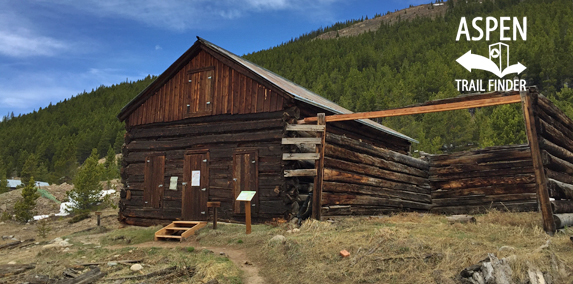Connects: Independence Pass Road (HWY 82), Green Mountain Trail

A building at the ghost town of Independence near Independence Pass
Aspen, CO – Ghost Town
The Independence Ghost Town is a historic gold and silver mining town. At its’ peak in 1882 the Town of Independence had over 40 businesses, 3 post offices, and an estimated population of 1,500. The town has gone by the name Independence, Chipeta, Mammoth City, Mount Hope, Farwell, Sparkill and Hunter’s Pass. This is a site 16 miles up Independence Pass Road (HWY 82) toward Independence Pass, just past mile marker 57. The site is listed on the National Register of Historic Places as Independence and Independence Mill Site.
More information about Independence Ghost Town can be found at:
National Register of Historic Places – Independence and Independence Mill Site
Aspen Historical Society – Independence Ghost Town
Wikipedia – Independence, Pitkin County, Colorado
Mill Site
The story of Independence and the Farwell Mill begin after the publication of the Hayden Geologic Survey in the fall of 1878 for the mountainous region that was once part of the Ute Territory. As the snow began to melt and passage over what is now known as Independence Pass was possible, miners began to scour the hill sides looking for gold ore outcrops and staking their claims in the summer of 1879.
A wealthy Chicago investor, John V. Farwell, had already successfully built two mills, one in Georgetown and the other in Leadville. He hoped to follow suit with a third mill on the newly purchased claims of Independence, Legal Tender, Last Dollar and the Geld Placer.
Once summer came again in 1880, the Farwell Consolidated Mining Company started on plans to build a 10 stamp mill as well as dig the Brown Tunnel north from a low point to reach the ore above. By January 1881, both the mine and mill were generating profits, and soon after plans were made to build a second 20 stamp mill (the structure you are standing near) at the portal to the Brown Tunnel. Like many “company” towns, most residents worked for the mine since it owned the majority of producing claims. However, the town also served as a center for commerce, communication and transportation along the new toll road, so many businesses were opened to support the miners as well as the travelers entering the new mining territory.
While many prospectors tried their luck staking their own claims to strike it rich, the Farwell Mine was the only real claim that produced significant amounts of gold ore in Independence. The real riches in silver ore were being discovered just 16 miles away in a lower elevation mining town called Aspen, where many of Independence’s population moved by the late 1880s.
The Trail
Walk in the footsteps of the old miners and enjoy a gentle hike along the old stage road to the main Independence town site from the Farwell Mill. The hike is about one mine long in each direction with historical signs to guide you along the path.
Your donations matter! Independence is a Nationally Registered Historic Site maintained by the Aspen Historical Society, a 501c3 nonprofit, in partnership with the White River National Forest Service & Independence Pass Foundation. All funds are used to help ongoing preservation of trails, picnic areas, signage, facilities, and to provide Interpreters. Thank you for your support.”
By 1860 around 300 people were living in the camp. By 1881 the population had grown to 500 souls and a business directory listed 11 firms (4 grocery stores, 4 boarding houses and 3 saloons). The camp reached its peak activity in 1882 with over 40 business establishments listed in the localdirectory. The population probably reached a peak somewhere between 1000 and 2000. It is said that the camp was on the wild side with many saloons, gambling halls and brothels.
The town had its own newspaper called the Independence Miner which was established in October 1881, but apparently it was very short-lived. Some of the more prominent business establishments during the peak of activity included the Connor House, the “finest boarding house in Independence,” the New England House on the east end of Main Street run by a Mrs. Briggs, the Independence House where a miner would get room and board for $2 per day, the Grand Hotel, and the Langstaff Bros. General Store which carried all manner of groceries, wine and liquor. It also had a bank even before Aspen or Ashcroft.
Mining activity waned after 1882 and by 1888 fewer than 100 residents remained in the camp. Most business firms had closed or moved to Aspen.
By the turn of the century Independence was practically a ghost town. The town had its hermit, now deceased, called the Mayor of Independence and thought to be an old-timer in the area named Jack Williams.
Mining Activity
Independence was primarily a gold camp. The first good strike was called the Independence following its discovery on July 4. It was also called the Last Dollar by some.
The Farwell Mining Co. was incorporated in 1879, and by 1880 had acquired most of the better mining claims in the area. These included the Independence No’s. 1, 2 & 3, the Last Dollar, the Legal Tender, the Mammouth, the Mount Hope, the Champion, the Sheba, the Friday and the Dolly Varden, The Farwell mines, particularly the Independence, were the most productive mines and were worked intermittently till around 1900. Peak activity periods were 1880-1882 and 1898-1900. There was another spurt of mining interest in 1907-08, and since then even to the present, an occasional prospector can be found trying his skill and luck.
The Farwell stamp mill was erected in 1880 and began operations in 1881. It was originally constructed with 15 stamps but was enlarged in late 1881 to
30. Power was provided by steam and water. In 1881 the mill produced $100,000 worth of gold. The mill closed in January 1883 after mining waned in 1882. The mill operated sporadically for the next 40 years until it was finally torn down in the early 1920s. The Farwell interests also had a large sawmill associated with the mining operations.
Names
As was true for so many Colorado mining camps, Independence went by other
names at various times. Other names it was called included Chipeta, Mammouth City, Mount Hope, Farwell and Sparkill. In July 1881 the camp was renamed Chipeta in honor of the great Ute Chief Quray’s wife and duly incorporated. However, in September 1881 the people voted to determine whether Chipeta or Mammoth City should be the name of the camp. In February 1882 the name was changed again to Sparkill, also the name of the local Post Office. It remained Sparkill from 1882 to 1887 when it apparently reverted to Independence. As was also true for many Colorado mining camps, the name of the local Post Office wasn’t necessarily the same as the camp. In fact, Independence once had 3 different post offices with 3 different names at nearly the same time during 1881.”


























sad